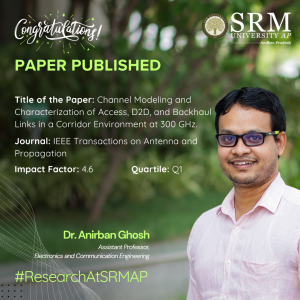 Dr Anirban Ghosh, an esteemed Assistant Professor in the Department of Electronics and Communication Engineering, has recently published a significant research paper titled “Channel Modeling and Characterization of Access, D2D, and Backhaul Links in a Corridor Environment at 300 GHz.” This paper has been featured in the prestigious Q1 Journal, IEEE Transactions on Antenna and Propagation, with an impressive impact factor of 4.6.
Dr Anirban Ghosh, an esteemed Assistant Professor in the Department of Electronics and Communication Engineering, has recently published a significant research paper titled “Channel Modeling and Characterization of Access, D2D, and Backhaul Links in a Corridor Environment at 300 GHz.” This paper has been featured in the prestigious Q1 Journal, IEEE Transactions on Antenna and Propagation, with an impressive impact factor of 4.6.
Dr Ghosh’s research delves into the intricate aspects of channel modelling and characterisation, focusing on access, device-to-device (D2D), and backhaul links within a corridor environment at a high frequency of 300 GHz. This study is poised to make substantial contributions to the field of wireless communication, particularly in enhancing the understanding and development of next-generation communication systems.
The publication in such a renowned journal underscores the quality and impact of Dr. Ghosh’s work, reflecting the cutting-edge research being conducted at SRM University – AP. The university community extends its heartfelt congratulations to Dr. Ghosh for this remarkable achievement and looks forward to his continued contributions to the field of electronics and communication engineering.
Abstract:
This paper presents comprehensive double-directional channel measurements at 300 GHz across various corridor scenarios, including Access, Device-to-Device (D2D), and Backhaul, using an in-house developed channel sounder. The measurements, validated by ray tracing simulations, reveal that while 300 GHz quasi-optical propagation in corridors can be modeled using ray optics, non-trivial propagation phenomena, such as quadruple-bounce reflections, also occur. To accurately model these mechanisms, a quasi-deterministic (QD) channel model combining deterministic and random components is proposed. The QD model results align well with observations, highlighting similar propagation mechanisms for Access and D2D scenarios, while Backhaul scenarios show Line-of-Sight (LoS) impacts from ceiling reflections. These findings are crucial for designing next-generation THz communication systems.
Explanation of Research in Layperson’s Terms
This research contributes to building the next generation of communication networks, which will significantly impact society by improving connectivity, supporting technological advancements, and promoting economic development, and bringing forth several futuristic applications.
Practical Implementation
The results align with the design of high-frequency ultra-high speed, low-latency, reliable communication envisioned for several futuristic applications using beyond 5G and 6G networks.

The measurement scenarios explored in the paper.
Collaborations
Prof. Minseok Kim
Professor, Faculty of Engineering, Course of Electrical and Electronics Engineering
Niigata University, Japan.
e-mail: mskim@eng.niigata-u.ac.jp
Future Research Plans
The efforts would be extended to other communication scenarios for a similar study. Additionally, generating appropriate channel models, coverage design, link budget, etc for the explored and unexplored scenarios would also encompass an interesting study.

